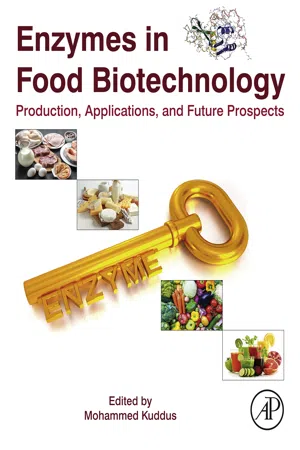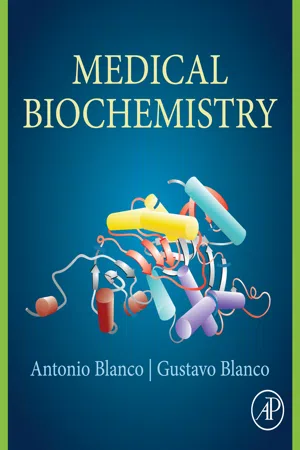Biological Sciences
Exoenzymes
Exoenzymes are enzymes produced by cells that are released outside of the cell to break down large molecules into smaller ones. They play a crucial role in the digestion of nutrients by organisms and are also involved in processes such as decomposition and nutrient cycling in the environment. Exoenzymes are important for the efficient utilization of resources by living organisms.
Written by Perlego with AI-assistance
Related key terms
6 Key excerpts on "Exoenzymes"
- eBook - ePub
- Douglas L. Karlen, Diane E. Stott, Maysoon M. Mikha(Authors)
- 2021(Publication Date)
- ACSESS(Publisher)
11 Metabolic Activity– EnzymesVerónica Acosta‐Martínez, Lumarie Pérez‐Guzmán, Kristen S. Veum, Márcio R. Nunes, and Richard P. DickIntroduction
The microbial component of the soil biological community produces hundreds of enzymes that mediate biochemical reactions associated with decomposition processes in soil (Figure 11.1 ). Many soil microorganisms have dual purposes, producing enzymes to gain energy and releasing products that other organisms can metabolize. Soils vary in the amount, type, and distribution of enzymes due to their inherent soil organic matter (SOM) content, chemistry, texture, and predominant microbial community (Figure 11.1 a). In addition, several management factors also influence enzyme stability, fate, and overall activity making enzymes useful soil ecosensors.Enzymatic activity in soil can be affected by management related factors and natural/fixed factors (a), and by their distribution within intracellular or extracellular locations (b), which will have an influence in overall soil health and crop productivity (c).Figure 11.1Soil enzymes can exist intracellularly (inside the cytoplasmic membrane) where they contribute to cellular life processes, or within the soil matrix as extracellular (abiontic) entities (Figure 11.1 b). Both types contribute to potential enzyme activity in soils (Burns et al., 1972 ; Burns, 1978 ; Skujiņš, 1976 ). Extracellular enzymes, as defined by Skujiņš (1976 ), are those exclusive of live cells and excreted to the soil by microbes to: (1) hydrolyze substances that are too large or insoluble to be taken up directly by cells, (2) detoxify the surrounding environment, and/or (3) create a favorable environment for survival of the organism. The abiontic enzymes identified by McLaren et al. (1957 , 1962 ) using soil sterilized by γ radiation was devoid of viable cells but still hydrolyzed urease and phosphatase substrates. Functionality of abiontic enzymes was subsequently confirmed using chloroform fumigation (Klose & Tabatabai, 1999 ; Klose & Tabatabai, 2002 ) and microwave irradiation (Speir et al., 1986 ; Knight & Dick, 2004 ) to sterilize the soil. The importance of these enzymes to soil health was documented by Knight and Dick (2004 ) who also found that abiontic β‐glucosidase activity was able to detect land management impacts. This is important because abiontic enzymes accumulate along a steady trajectory, significantly reducing short‐term variability (Bandick & Dick, 1999 ; Ndiaye et al., 2000 - eBook - ePub
Enzymes in the Environment
Activity, Ecology, and Applications
- Richard G. Burns, Richard P. Dick(Authors)
- 2002(Publication Date)
- CRC Press(Publisher)
188 ). This novel technique allows not only the separation of the different bacterial extracellular enzymes but also the simultaneous determination of the kinetic parameters of the individual enzymes. A wider application of this promising new tool probably will lead to a better understanding of the diversity of bacterial extracellular enzymes in the natural aquatic environment. It might also provide new insights into the dynamics of the transformation of the different compound classes of the DOM.The need to improve our understanding of substrate specificity among extracellular enzymes, as well as the diversity of organisms that produce them, is also highlighted by a comparative study in 2000 of enzyme activity in bottom water and sediments from Skagerrak (North Sea/Baltic Sea transition) (162 ). Potential hydrolysis rates of six polysaccharides (pullulan, laminarin, xylan, fucoidan, arabinogalactan, chondroitin sulfate) were compared in bottom water and underlying surface sediments. Three of the six polysaccharides (pullulan, arabinogalactan, fucoidan) were not hydrolyzed in bottom water, although they were (and in the case of pullulan, rapidly) hydrolyzed in sediments (162 ). Molecular biological investigations have revealed fundamental differences between free-living bacteria and bacteria concentrated on particles and in sediments (63 ,189 ); the extracellular enzymes expressed by these communities may differ as well.VIII. MOLECULAR BIOLOGICAL AND BIOTECHNOLOGICAL ASPECTS OF MARINE-DERIVED ENZYMES
Until recently, investigations of marine-derived enzymes were hampered by the necessity of isolating a microbe in pure culture and then obtaining sufficient quantities of an enzyme for biochemical and structural investigations. These requirements are now a less formidable obstacle, thanks to developments in molecular biology. In particular, the ability to obtain and amplify DNA from cultured or uncultured microbes, and to express foreign genes in host organisms, has greatly increased the range of enzymes that can be sought and characterized. - Natuschka M. Lee(Author)
- 2020(Publication Date)
- De Gruyter(Publisher)
4 Extremozymes: from discovery to novel bio-productsGiannina EspinaPaulina Cáceres-MorenoDaniela Correa-LlanténFelipe SarmientoJenny M. Blamey4.1 Abstract
Biocatalysis has proven to be an essential industrial tool for converting raw material into valuable bio-products. The discovery of new enzymes, the improvement of enzymatic features, and the development of new processes for enzyme production will drive future innovation.For the chemical industry, the use of enzymes presents important benefits, which include higher selectivity, increased sustainability, and a low toxicity. These benefits are translated in cleaner production processes and lower environmental impact.Enzymes derived from extremophiles, or extremozymes, often have extraordinary properties, which include being able to carry out reactions at nonstandard conditions (e.g. high or low temperatures, acidic or alkaline pH, high concentrations of salt or organic solvents, and high pressure) where other enzymes underperform.Working with extremophiles and their native extremozymes is difficult due to the culture conditions required; they have usually low cell yield and low enzyme expression. For these reasons, to achieve industrial production levels, available extremozymes have been overexpressed in suitable heterologous host-vector systems.In this review, we present a road map to find enzymes from extremophiles. We will explore the process from discovering an enzymatic activity in a microbial crude extract through the application of a functional biochemical approach, up to the development of a new enzymatic product.4.2 Biocatalysis benefits and barriers
Enzymes are biocatalysts that improve the rate of biochemical reactions by lowering their required activation energy. A reaction that would normally take a long time, such as oxidation, can occur in just milliseconds if the appropriate enzyme is used. Due to the high selectivity of enzymes, it is possible to optimize chemical reactions in different manners: maximizing the use of energy, minimizing the generation of secondary products, and reducing the reaction time. Thanks to the commercial, technical, and environmental benefits that the use of enzymes offers, biocatalysis is increasingly gaining interest for application in several industrial processes.- eBook - ePub
Enzymes in Food Biotechnology
Production, Applications, and Future Prospects
- Mohammed Kuddus(Author)
- 2018(Publication Date)
- Academic Press(Publisher)
Chapter 1Introduction to Food Enzymes
Mohammed Kuddus Department of Biochemistry, College of Medicine, University of Hail, Hail, Saudi ArabiaAbstract
Enzymes are a biological substance that accelerates the rate of various biochemical reactions in a living organism without being used up in the reaction. The actions of enzymes are specific and biodegradable. Enzymes are involved in most of the biochemical reactions going on in microorganisms, plants, animals, and human beings. Even though enzymes are produced inside living cells, they can work actively in vitro, making them useful in industrial processes. The assimilation of enzymes in food processing is well known, and devoted research continues consistently to solve the worldwide food crisis. This chapter covers the basics of enzymes along with sources of different enzymes and their applications within various food industries.Keywords
Enzyme; Cofactor; Enzyme action; Industrial enzymes; Food processingAbbreviationsIUB International Union of BiochemistsIU International UnitsEC Enzyme Commission°C degree celsiuspH potential of hydrogenES complex enzyme substrate complexEIS complex enzyme inhibitor substrate complexK mMichaelis constantV maxmaximum velocityNAD nicotinamide adenine dinucleotideATP adenosine triphosphate1.1 Enzymes
The presence of enzymes in nature have been well known for over a century. However, the first enzyme urease was isolated in crystalline form from the jack bean by James B. Sumner in 1926 (Sumner, 1926 ). Enzymes, also known as biocatalysts, are a biological substance that initiates or accelerates the rate of a biochemical reaction in a living organism, without itself being consumed in the reaction. Even though enzymes are produced inside the living cells, they can work actively in vitro, making them useful in industrial processes. Enzymes are complex protein molecules and are nature's own biocatalysts produced by living organisms to catalyze the biochemical reactions required to sustain life. Mostly enzymes are proteins, but not all. RNA and antibodies can also act as catalysts known as ribozymes and abzymes, respectively. The literature suggested that > 5000 biochemical reaction types are catalyzed by the enzymes (Schomburg et al., 2013 - eBook - ePub
- Antonio Blanco, Gustavo Blanco(Authors)
- 2017(Publication Date)
- Academic Press(Publisher)
Countless chemical reactions take place at a given time in every living being. Many of them transform exogenous substances, which come with the diet, to obtain energy and the basic materials that will be used for the synthesis of endogenous molecules.Biochemical transformations are performed at a remarkable fast rate and with great efficiency. To reproduce them in the laboratory, these reactions would need extreme changes in temperature, pH, or pressure to take place; these changes are not compatible with cell survival. Under normal physiological conditions (37°C for warm-blooded organisms, pH near neutrality, and constant pressure), most of the reactions would proceed very slowly or may not occur at all. It is the presence of catalysts that allow chemical reactions in living beings to occur with great speed and under the mild conditions that are compatible with life.Enzymes are biological catalysts
A catalyst is an agent capable of accelerating a chemical reaction without being part of the final products or being consumed in the process. In biological media, macromolecules called enzymes act as catalysts.As any catalyst, enzymes work by lowering the reaction activation energy (A e ) (see p. 152). Enzymes are more effective than most inorganic catalysts; moreover, enzymes show a greater specificity of effect. Usually inorganic catalysts function by accelerating a variety of chemical reactions, whereas enzymes catalyze only a specific chemical reaction. Some enzymes act on different substances, but generally, these are compounds with similar structural characteristics and the catalyzed reaction is always of the same type.The substances that are modified by enzymes are called substrates .The specificity of enzymes allows them to have high selectivity to distinguish among different substances and even between optical isomers of a compound. For example, glucokinase, an enzyme that catalyzes d -glucose phosphorylation, does not act on l - eBook - ePub
- Reinhard Renneberg, Vanya Loroch(Authors)
- 2016(Publication Date)
- Academic Press(Publisher)
Fig. 2.12 ).It comes as no surprise that industry has so far mainly focused on extracellular enzymes , as they can be extracted easily and cheaply from a medium and do not require cost- and labor-intensive cell disruption and purification procedures.A bacterial cell contains more than a thousand different enzymes, and any intracellular enzyme must be separable from other enzymes and cell structures.There are two distinct properties in proteins that can be used for separation purposes—molecular mass and electric charge. All protein separation methods known to date utilize these techniques: salt precipitation, movement through an electric field (electrophoresis), binding to charged or noncharged carriers (chromatography), mass spectrometry, and other methods.2.6 Amylases Are Used for Brewing, Baking, and Desizing
Duke William IV of Bavaria issued the purity law for beer in 1516. It stated that “nothing but barley, hops, and water should be used for beerbrewing.” This rule is still followed in Germany, whereas in most other countries, economic considerations have led to the replacement of malt by ungerminated grain, corn, or rice. As these hardly contain any enzymes, ready-made enzyme preparations containing amylases, glucanases, and proteases obtained from mold fungi or bacteria, known as brewing enzymes , are added.According to the Japanese brewery Kirin, the annual per capita consumption of beer (in 2014) was: Ranking first, Czech Republic at 142.6 L/capita. Ranking second, the Seychelles (!) at 114.6L, third: Austria (104.8 L), fourth: Germany (104.7 L), fifth: Namibia (104.00 L). The United States are 17th in ranking with 75.8 L, the United Kingdom at 27th with 67.7 L. China is, however, with 1.3 billion citizens, the largest market in the world. Worldwide, beer consumption in 2014 increased by approximately 0.4% from the previous year, amounting to around 189 million kL. China, which has 23.7% of the global market share, has occupied the number one position for 12 consecutive years since 2003. The volume consumed in China is 13.1 million kL more than that in the United States, while Brazil takes ranks third behind the United States.
Index pages curate the most relevant extracts from our library of academic textbooks. They’ve been created using an in-house natural language model (NLM), each adding context and meaning to key research topics.





